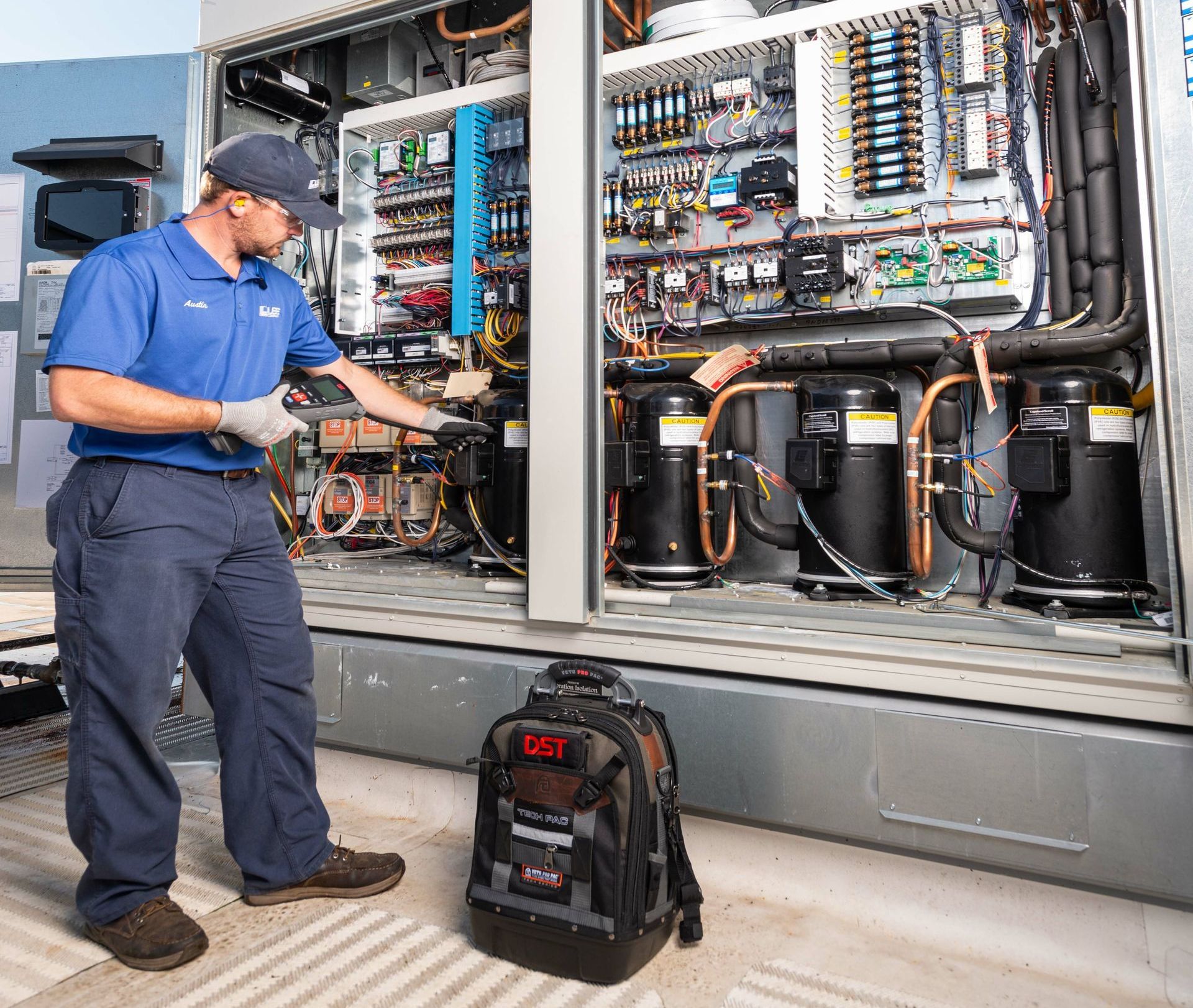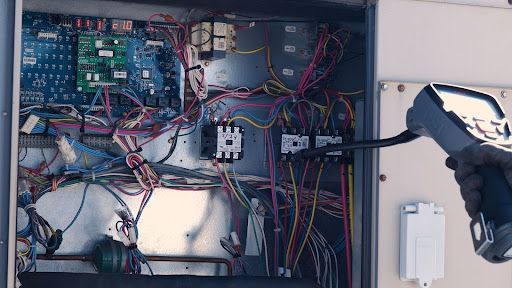A Comparison of DST's PdM vs. Traditional PM Approach

With DST’s ultrasound predictive technology, HVAC/R technicians of any skill level can
- Perform a Predictive Maintenance (PdM) service in up to half the usual time
- Identify early-stage mechanical and electrical failures
- Report and repair issues for customers before they become expensive, surprise failures
A 25-50% time savings is created by the information the technician captures using DST
to identify areas that are running normally and do not require further inspection, thus
eliminating many steps required in a traditional PM.
Following is a step-by-step comparison of a traditional roof top unit
(RTU) PM and the DST PdM, which demonstrates how a more insightful
preventive maintenance service can be completed faster.
- Check system data tag to ensure correct documentation. Using DST’s OCR nameplate feature to capture the information on the data plate ensures the correct data is entered; an image of the data plate is easily accessed in the DST platform for visual verification.
- Visually inspect and listen for unusual sounds coming from the unit. Ensure unit is intact with no open or missing panels.
- Turn off service disconnect for unit. If a disconnect box is provided, open the box and inspect for debris and electrical connections.
- Remove filters and inspect blower belt and replace them if necessary. During this step the technician will check the condition of the evaporator coil and check the blower system’s pulleys for wear.
- Check blower wheel(s) for obstructions. Visually check blower wheel to make sure it is intact and there is no debris inside blower housing.
- Clear condensate drain line and treat the drain pan if necessary.
- Check electrical panel for any exposed wiring or tripped breakers.
- Check condenser fan blades for cracks or damage of any kind.
- Check condenser coils for dirt, debris, or oil spots.
- Clean condenser coils if necessary.
- Turn on service disconnect.
- Force individual components on via test sequence, BAS, or jumper wires.
- Take DST readings on compressors, condenser fans and blower assembly.
The DST ultrasound readings can eliminate 17 steps of a traditional PM
When the ultrasound readings are taken on the compressors, condenser fan motors, blower motors, and bearings associated with the blower housing, the DST analysis will provide the technician and customer with comprehensive real time diagnostics on equipment condition and life expectancy.
In a matter of minutes, DST can call out many of the issues that take 17 additional steps to collect using traditional tools such as amp meters, refrigerant gauges, meggers, and capacitor testers.
Eliminate checking and recording amp draws
- DST inspections taken on motor windings, compressors and condenser fan motors are compared to the Sound Signature™ database when the recording is analyzed by DST’s patented machine learning platform.
- The tech will be notified by an “ELECTRICAL” Sound Signature™ when there is a phase imbalance, or the windings are breaking down due to wear over time.
- The technician will only need to take amp draws and meg the motor when flagged by DST.
- It is not necessary for the technician to use an amp meter or record the amp draws of each individual leg of power to a motor to identify any phase imbalance due to loose connections, improper wiring sizes, voltage drop across a contactor, resistance in the motor itself, or a faulty capacitor, as DST readings capture and analyze this data.
Eliminate checking for bearing issues
- By taking DST readings on the bearings of the blower motor and blower shaft bearings, the technician can see their current condition.
- The technician does not need to be highly skilled at determining the sounds made by damaged, scratched, dry, or loose bearings in motors and blower housing.
- The unit does not need to be shut down for this procedure, which eliminates a step in the process. The technician can determine alignment and belt tension issues by reading the results of the DST inspection and following recommendations.
- It is not necessary for the technician to remove any belts and hand-turn pulleys.
- The technician receives a DST analysis of the individual bearings with Sound Signatures™ alerting them of issues like BEARING (indicating early-stage wear), SCRATCHED, DAMAGED, LOOSE, ROTATING and/or DRY.
- If any of these issues are called out in the DST analysis of the single inspection point for a bearing, Recommended Actions will appear advising the technician that further review is required.
- Most importantly, the technician will know when to grease the bearings and when not to, and avoid over-greasing the bearings and damaging the seals.
- If DST’s analysis shows nothing unusual in the Sound Signature™ recording and flags the bearing Green, then the Technician can move on to the next task, assured that the bearing is in a normal condition.
- The DST report confirming that the bearings are in good health can be presented to the customer.

Eliminate checking for loose electrical connections
- Traditionally, every electrical connection to a motor is checked during a PM for voltage drop and phase imbalances, as these loose connections can cause the motor windings to overheat, shortening the life of the motor.
- This step can be very time consuming since the technician must check every lug, screw, bolt, and spade connector for looseness, plus take voltage readings across every leg of a contactor to ensure there is no voltage drop going to the motors or compressors.
- With DST, this assessment can be done in a matter of minutes.
- The technician will only need to check for loose electrical connections if the “ARCING” Sound Signature™ appears in the analysis, which indicates a zapping or popping sound was detected when DST readings were taken.
- The technician then puts the MSi150 into discovery mode and slowly traces the circuits while wearing the headset to listen for any loose connections.
- The technician will hear the arcing (zapping or popping) sound most intensely at the loose connection.
- If no loose connection is found, then the arcing is taking place inside the windings of the motor. This is due to the protective coating on the windings themselves breaking down and slowly burning away, which will over time destroy the motor. If this is the case, then DST has this documented on the analysis and the motor needs to be monitored or replaced before the motor shorts to ground. When a short to ground or a “burnout” happens inside a compressor, the long-lasting effects of acid and oil that is compromised can damage a refrigeration circuit even after a repair has been completed.
Eliminate taking and recording refrigerant pressures
- By taking DST readings on A/C compressors, the technician can determine that the refrigerant pressures are correct in a refrigeration circuit without even connecting to their gauges. Along with a Delta T reading, this indicates that the compressor in that circuit is running and there is no need to document the low side and high side pressures to assure the customer that the system is running. All inspections are date and time stamped.
- The DST analysis will call out any issues with a compressor and the refrigeration circuit with the ELECTRICAL, ARCING, SCROLL DAMAGED, FLOODBACK, and HIGH SUPER HEAT Sound Signatures™.
- Flagged inspection points will trigger “Recommended Actions,” advising the technician of possible causes for the condition
- If DST’s analysis shows nothing in the Sound SignatureTM recording and DST flags the compressor Green, then the technician can move on to the next task, assured that the compressor is in a normal operating condition.
Eliminate inspecting condenser fan motors
- With DST, the technician only needs to take one 7-second ultrasound recording to inspect a condenser fan motor. The DST analysis will call out any Sound Signatures™ associated with phase imbalance or arcing due to loose connections or weak/faulty capacitors.
- The Sound Signature™ of ELECTRICAL will appear in the analysis if an issue is identified.
- If the bracket or the shaft of the motor is loose, the Sound Signature™ LOOSE will appear in the analysis.
- If the bearings are damaged, the Sound Signature™ BEARING or DAMAGED will be displayed in the analysis.
- All these issues can be detected with a single recording using DST without shutting down the system and inspecting the motor by hand and testing the capacitors.
- DST can also call out any issues with the bearings inside the motor before they are even perceptible to the human ear.
- If the DST Analysis shows no Sound Signature™ issues, then the technician can move on to the next task assured that the motor is in good condition.
- With DST, it is not necessary to perform these traditional steps:
- Listen to and observe the fan motor while it is running to ensure there are no bearing or capacitor deficiencies (for a single-phase motor).
- Shut down the system to test the capacitors and check for any loose brackets that hold the motor in place.
- Remove the fan guards and inspect the motor by hand, provided the technician has the experience to know what to look and listen for when the motor is operating.
To complete the DST roof top unit predictive maintenance inspection, the technician performs these final two steps:
- Take and record Delta T. The technician should measure the temperature difference across the evaporator coil. This can be done with all stages running or for each stage individually.
- Use DST in Discovery Mode to inspect for leaks or electrical issues. If low refrigerant charge is identified during the PdM, the MSi150 is an excellent leak detection tool. The technician can also perform one final sweep of the electrical panel to ensure there are no loose electrical connections.
With DST's ultrasound predictive technology, HVAC/R technicians of any skill level can perform a PdM service in half the usual time.
Using DST and the MSi150 in Discovery Mode as the primary tool in performing a PdM on a roof top unit can eliminate 17 time-consuming steps of a traditional PM. The technician will not need to perform unnecessary steps. If the DST analysis does not call out any issues, the technician can move on to the next task.
HVAC/R contractors, facility managers, and building owners using DST gain these competitive advantages:
- Provide their technicians and customers with accurate, fact-based data for their HVAC/R equipment, including chillers, water pumps, boilers, compressors, air handlers and cooling towers
- Ability to perform a PdM up to 50% faster
- Enjoy significant labor cost savings
- Eliminate surprise mechanical and electrical failures
- Be more efficient and perform more work with the same number of technicians
LEAVE A REPLY
We will get back to you as soon as possible.
Please try again later.
Copyright Discovery Sound Technology. All Rights Reserved
